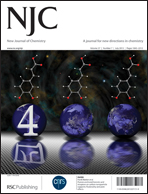The antiradical capacity of cysteamine- and cysteine-flavan-3-ol derivatives of green tea catechins bearing the pyrogallol moiety was evaluated using two stable triphenylmethyl radicals, the tri-potassium salt of a tris(4-hydroxysulfonyltetrachlorophenyl)methyl radical (K3TSPTM) and a tris(2,4,6-trichloro-3,5-dinitrophenyl)methyl radical (HNTTM), as chemosensors in a buffer solution at pH 7 and in the CHCl3–MeOH mixture (2 : 1, v/v), respectively. The different results obtained using HNTTM or K3TSPTM lie in the chemical nature of these radicals and, therefore, in their reduction potentials, and in the solvent used in the experiments. The K3TSPTM radical was selectively sensitive to the pyrogallol moiety in water like TNPTM was in organic solvents, and as a chemosensor is closer to the biological processes by using aqueous media as solvent. The new radical is a useful tool to detect highly reactive phenolic positions that are also the most biologically active as shown by the results on the viability and apoptosis of the colon adenocarcinoma cell line HT-29.

You have access to this article
 Please wait while we load your content...
Something went wrong. Try again?
Please wait while we load your content...
Something went wrong. Try again?


 Please wait while we load your content...
Please wait while we load your content...